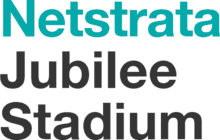The St. George Dragons was an Australian rugby league football club from the St George District in Sydney, New South Wales that played in the top level New South Wales competition and Australian Rugby League competitions from the 1921 until the 1997 ARL season, as well as the unified 1998 National Rugby League season. On 23 September 1998, the club formed a joint venture with the Illawarra Steelers, creating the St. George Illawarra Dragons team which competed in the 1999 NRL season and continues to compete in the league today. As a stand-alone club, it fields teams in the NSWRL underage men's and women's competitions, Harold Matthews Cup, S.G. Ball, and Tarsha Gale Cup.
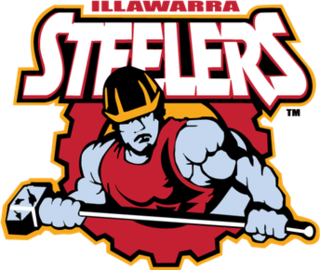
The Illawarra Steelers are an Australian rugby league football club based in the city of Wollongong, New South Wales. The club competed in Australia's top-level rugby league competition from 1982 until 1998. On 13 December 1980, they were the first non-Sydney based team to be admitted into the New South Wales Rugby League premiership, with the Canberra Raiders being admitted later ensuring an even number of teams in the competition for the start of their first season, 1982. Over their seventeen years in the top grade, the club received three wooden spoons, made the play-offs twice and had a total of three of its players selected to play for the Australia national rugby league team.
Robert Henry Stone was an Australian professional rugby league footballer and official. He played 281 games for the St. George Dragons including 170 games in first grade mainly at prop. Stone achieved representative honours including being a member of the first New South Wales State of Origin team. Stone later became the executive officer at St. George where his most notable achievement was having St George Illawarra Dragons return to Oki Jubilee Stadium in Kogarah from 2003.

Leichhardt Oval is a rugby league and soccer stadium in Lilyfield, New South Wales, Australia. It is currently one of three home grounds for the Wests Tigers National Rugby League (NRL) team, along with Campbelltown Stadium and Western Sydney Stadium. Prior to its merger with the Western Suburbs Magpies, it was the longtime home of the Balmain Tigers, who used the ground from 1934–1994 and 1997–1999. It was named after Ludwig Leichhardt.

Parramatta Stadium was a sports stadium in Parramatta, New South Wales, Australia, 24 km (15 mi) west of Sydney CBD. The stadium was the home ground of several western Sydney-based sports teams, at the time of closure the most notable were the Parramatta Eels of the National Rugby League and the Western Sydney Wanderers of the A-League.
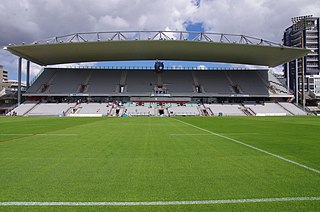
Wollongong Showground, known as WIN Stadium for sponsorship reasons, is a multi-purpose stadium located in Wollongong, Australia. The stadium was officially opened in 1911. From 1982 until 1998 it played host to every home match for the Illawarra Steelers NRL team, and is still the team's home ground in the lower grade competitions. It is now used as one home ground of the St George Illawarra Dragons rugby league side and Wollongong Wolves of the National Premier Leagues NSW.

The St. George Illawarra Dragons are an Australian professional rugby league football club, representing both the Illawarra and St George regions of New South Wales. The club has competed in the National Rugby League (NRL) since 1999 after a joint-venture was formed between the St. George Dragons and the Illawarra Steelers. The club officially formed as the game's first joint-venture club on 23 September 1998 and remains the only inter-city team in the NRL. The team has its headquarters and leagues clubs in both Wollongong and the Sydney suburb of Kogarah, and trains and plays games regularly at WIN Stadium in Wollongong, as well as at Jubilee Oval in Kogarah. From 1999 to 2006 the club was jointly owned by the St. George Dragons 50% and Illawarra Steelers 50%. In 2006 WIN Corporation purchased 50% of the Illawarra Steelers stake in the club before purchasing the rest of the Illawarra Steelers' share in August 2018.

Jamie Soward is an Australian former professional rugby league footballer, and currently head-coach of St. George Illawarra Dragons Women in the NRLW.

Dolphin Stadium is a sports stadium in the suburb of Kippa-Ring in the City of Moreton Bay, north of the adjoining Brisbane metropolitan city, Queensland, Australia. Formerly known as Moreton Daily Stadium under a previous naming rights agreement, the stadium serves as the home ground for the Redcliffe Dolphins rugby league club in the Queensland Cup, and NRL club, the Dolphins.

Endeavour Field is a rugby league stadium in the southern Sydney suburb of Woolooware, New South Wales, Australia. It is the home ground of the Cronulla-Sutherland Rugby League Club, which represents the Cronulla and Sutherland Shire areas in the National Rugby League competition. The Sharks are as of 2023 just one of two professional sporting clubs in Australia that own and operate their home ground as well as Western United's future home ground Wyndham City Stadium. The Sharkies Leagues Club sits beside the stadium.

Belmore Sports Ground, formerly known as Belmore Oval, is a multi-purpose stadium in Belmore, New South Wales, Australia. The park covers 22 acres (89,000 m2) and from 1951 has contained the Belmore Bowling Recreation Club green. It is close to Belmore railway station.

Brett Morris is an Australian former professional rugby league footballer who played on the wing and as a fullback for the St George Illawarra Dragons, Canterbury-Bankstown Bulldogs and the Sydney Roosters in the National Rugby League (NRL) and Australia at international level.
The 2009 NRL season was the 102nd season of professional rugby league football club competition in Australia, and the twelfth run by the National Rugby League. For the third consecutive year, sixteen teams competed for the 2009 Telstra Premiership title. The season commenced with the first match played on 13 March and ended with the grand final, played on 4 October. The Grand Final was won by the Melbourne Storm in their fourth consecutive grand final appearance. However, they were stripped of their Premiership on 22 April 2010 after they were found to be guilty of breaching the league's salary cap.

Sydney Football Club is an Australian professional women's soccer club based in Sydney, New South Wales, Australia. It competes in the A-League Women, the top tier of women's soccer in Australia.

Timoteo Lafai is a Samoan professional rugby league footballer who plays as a centre for the Salford Red Devils in the Super League and Samoa at international level..
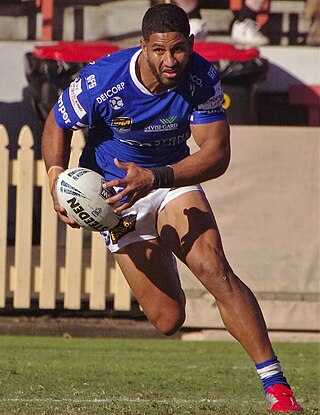
Nene Macdonald is a Papua New Guinean professional rugby league footballer who plays as a winger or centre for the Salford Red Devils in the Super League and Papua New Guinea at international level.
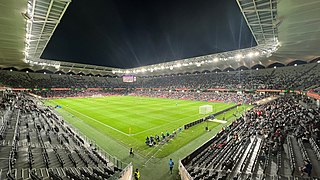
Western Sydney Stadium, commercially known as CommBank Stadium, is a multi-purpose rectangular stadium in Parramatta, within the Greater Western Sydney region, approximately 24 km (15 mi) west of Sydney CBD. It replaced the demolished Parramatta Stadium (1986) which in turn was built on the site of the old Cumberland Oval, home ground to the Parramatta Eels since 1947. The current stadium opened in April 2019 and has a 30,000-seat capacity. The stadium is owned by the NSW Government and built at a cost of $300 million. The stadium hosts games across the major rectangular field sports in Sydney.

Matthew Lawrence Dufty is an Australian professional rugby league footballer who plays as a fullback for the Warrington Wolves in the Betfred Super League.
The St. George Illawarra Dragons are a rugby league club jointly based in Kogarah and Wollongong, New South Wales who compete in the National Rugby League. The club was formed on 23 September 1998 by a merger of the St. George Dragons and the Illawarra Steelers and they played their first competitive match in 1999 against the Parramatta Eels, losing 20–10. The club shares home games between Jubilee Oval and Wollongong Showground.
